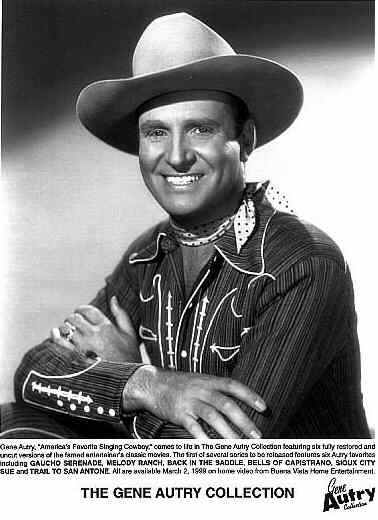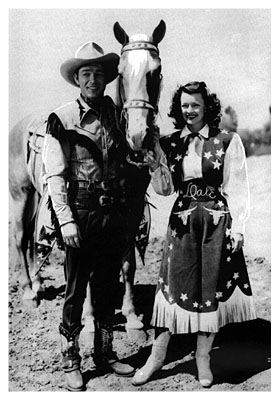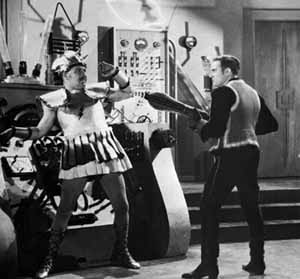
His old movie was coming on TV
And I said,"Well let me tell you about him son..."
"Why he could ride a horse, play his guitar, and sing, all at the same time
And I was riding right along there beside him
On that broomstick pony of mine
And you know his pistol never ran out of bullets
When the bad guys had to be stopped?
And somehow, his bullets never drew any blood
But the bad guys dropped when he shot.
Yeah, old Gene was the image of justice
And goodness and purity...
And you know the way he rescued the rancher's daughter
It sent a thrill right up the aisle
And the ending would always send us home
With a good, victorious smile...
(From AMC's documentary, "Gene Autry, Melody of the
West")
A romanticized hero from a time gone by, the Singing Cowboy personifies our
vision of the good guy in the white hat. Whether battling cattle rustlers,
Nazi spies, or evil overlords from another planet, Our Hero could be counted
on to arrive in the nick of time.
The recipe for these films was simple. Take a heroic good guy riding a fiery horse, add a comic side-kick, mix with a pretty, spunky girl and a devious villain, stir in a soupçon of song and patriotism, and voila! Box office magic! It didn't matter if the story took place in the past or the present; it only mattered that in the end good would triumph over evil.
Appealing to both children and adults, singing cowboy
pictures had their heyday in the 30's and 40's. Gene Autry with
 Smiley Burnett, and Roy Rogers,
Dale Evans and Gabby Hayes were some of the most bankable stars around. It's
difficult to believe now, but in 1940, Gene Autry was the fourth most popular
movie star in America -- right behind Clark Gable! Even that most urbane
sophisticate, Cole Porter, got in on the action, penning "Don't Fence Me
In," a song recorded by nearly every singing cowboy that ever set foot on
a soundstage.
Smiley Burnett, and Roy Rogers,
Dale Evans and Gabby Hayes were some of the most bankable stars around. It's
difficult to believe now, but in 1940, Gene Autry was the fourth most popular
movie star in America -- right behind Clark Gable! Even that most urbane
sophisticate, Cole Porter, got in on the action, penning "Don't Fence Me
In," a song recorded by nearly every singing cowboy that ever set foot on
a soundstage.
Everything Our Hero stood for is summed up in Gene Autry's "Cowboy Code."
- He must not take unfair advantage of an enemy.
- He must never go back on his word.
- He must always tell the truth.
- He must always be gentle with children, elderly people, and animals.
- He must not possess racially or religious intolerant ideas.
- He must help people in distress.
- He must be a good worker.
- He must respect women, parents, and his nation's laws.
- He must be a patriot.
Of course, there's one rule he neglected to include:
- He must break into song whenever loping along on horseback.
The costumes for Singing Cowboys (and Cowgirls) range from the predictable
to the bizarre. Fringed and embroidered shirts, jeans with chaps and fancy
boots are always appropriate. Cowgirls, of course, would substitute a ruffled
skirt for the jeans and chaps. Villains almost always wear black and usually
have a pencil mustache.

A more unusual costume would be from "The Phantom Empire," the first
science-fiction/singing cowboy western. Your choices would then include "Spaceman
Spiff-like" attire for Our Hero and slinky sequined gowns for the lady villain.
"The Phantom Empire" gives you the additional option of coming as a robot
made from cardboard and sheet metal.
Join us on Sunday, April 25th for "They Went Thataway!" and afternoon of
eatin', drinkin', and singing...plus a train ride through the redwoods.
© March, 1999 by Karen Tully